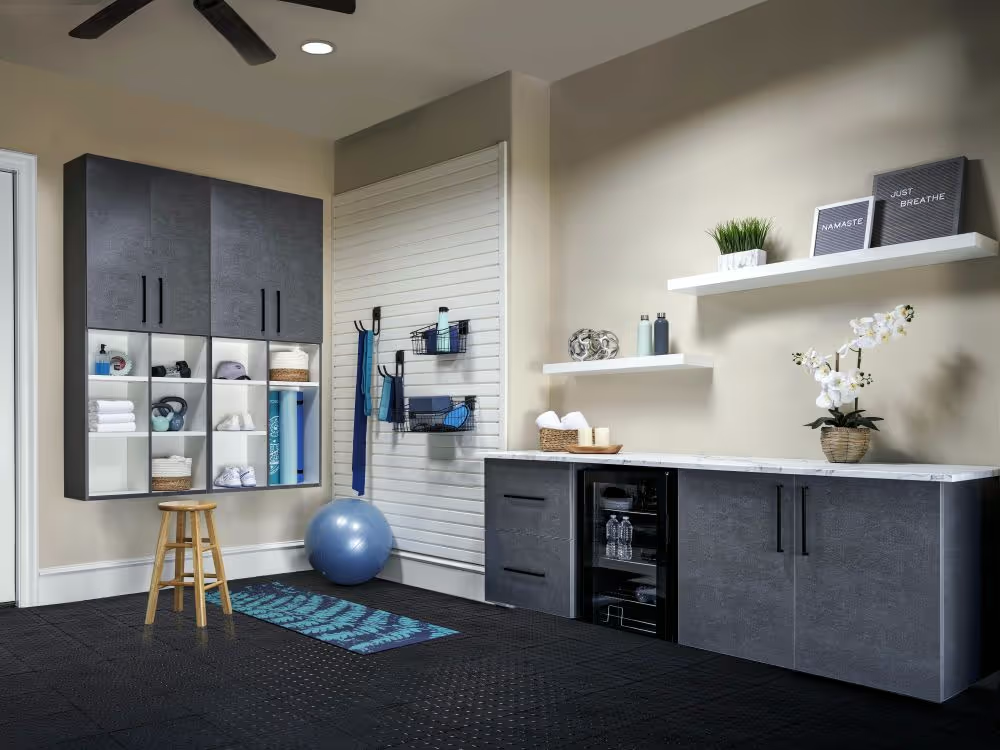Imagine investing thousands in a beautiful garage floor only to watch it bubble and peel within months, a nightmare many Vancouver homeowners face due to moisture issues. A professional polyaspartic garage floor can transform your space into a clean, durable, and beautiful extension of your home, but only when moisture problems are properly addressed first.
Unlike DIY epoxy kits, a professional polyaspartic system offers incredible resistance to stains and abrasion, won't yellow from sunlight, and can be ready for use in as little as 24 hours. However, there's a hidden threat that can destroy this investment: moisture vapor rising through your concrete slab.
Why Polyaspartic Garage Floors Fail: The Hidden Moisture Threat
Think of moisture damage like Vancouver's infamous "Leaky Condo Crisis." In that crisis, poorly designed building envelopes trapped rainwater, leading to rot and structural damage from the inside out. Similarly, a polyaspartic coating creates a non-breathable seal on your garage floor. If your concrete contains excess moisture, the coating traps that vapor, causing it to bubble, blister, and peel off resulting in complete coating failure.
The Vancouver Moisture Challenge
In our 20 years serving Vancouver homeowners, we've documented moisture failure rates increasing by 40% in low-lying areas like Richmond and Delta due to rising water tables and climate change effects. The combination of our region's geography and wet climate makes professional moisture assessment not just recommended, but essential for coating success.
Understanding Concrete Moisture Problems in Vancouver's Climate
Your concrete garage floor isn't the solid barrier it appears to be—it's more like a very dense sponge filled with microscopic pores that can wick moisture up from the ground below. Even if your floor looks and feels dry, it could be releasing invisible moisture vapor that will destroy any coating applied over it.
Common Moisture Sources in Greater Vancouver
Groundwater Issues:
- Heavy rainfall (1,200mm annually) creates high water tables
- Mountain runoff in North and West Vancouver increases seasonal moisture
- Poor drainage around foundations traps water against concrete slabs
Construction Factors:
- Many older homes (pre-1980) lack proper vapor barriers under concrete
- Clogged drain tiles or improper grading direct water toward foundations
- Settlement and minor foundation cracks allow moisture infiltration
Environmental Conditions:
- Coastal humidity maintains higher baseline moisture levels
- Temperature fluctuations cause expansion/contraction in concrete
- Seasonal freeze-thaw cycles can create microscopic cracks
Health Implications of Untreated Moisture
Leaving a moisture-compromised concrete floor untreated creates more than just flooring problems. The constant moisture evaporation makes garages feel damp and musty while creating ideal conditions for mold and mildew growth. Health Canada reports that indoor mold exposure can cause eye and throat irritation, respiratory issues, and worsened asthma symptoms, particularly affecting children and elderly family members.
The Science Behind Coating Failure: Bubbling and Peeling Explained
When a non-breathable polyaspartic coating is applied over concrete with excess moisture, failure follows a predictable pattern:
- Vapor Pressure Buildup: Moisture that previously evaporated freely becomes trapped beneath the coating
- Adhesion Loss: Trapped vapor creates pressure that literally pushes the coating away from the concrete surface
- Chemical Attack: Moisture carries alkaline salts from concrete that chemically attack the coating's adhesive bond
- Coating Delamination: The combination of physical pressure and chemical attack causes bubbling, blistering, and eventual peeling
Critical Moisture Thresholds
Professional coating systems require concrete moisture levels below specific thresholds:
- Standard polyaspartic coatings: Maximum 75% RH (Relative Humidity)
- High-performance systems: Can tolerate up to 80% RH
- Moisture barrier systems: Required above 80% RH
Professional Moisture Remediation Solutions
When testing reveals concrete moisture levels above coating thresholds (typically 75-80% RH), the project isn't over; It requires professional moisture mitigation.
Moisture Vapor Barrier Systems
Professional moisture barriers use 100% solids epoxy products designed to block vapor transmission and create a dry foundation for polyaspartic topcoats. These systems require precise application:
Product Example: Mapei Planiseal MR
- Water-based, two-component epoxy designed for high-moisture concrete
- Can be applied to damp surfaces (up to 95% RH)
- Creates impermeable barrier resistant to hydrostatic pressure
- Cures to form smooth, primed surface for topcoats
Professional Installation Process
Step 1: Surface Preparation
- Diamond grinding removes surface contaminants and laitance
- Creates mechanical profile for optimal barrier adhesion
- Vacuum extraction removes all dust and debris
Step 2: Barrier Application
- Product mixed according to manufacturer specifications
- Applied at specified thickness (typically 10-15 mils dry film thickness)
- Consistent coverage essential for effective moisture blocking
Step 3: Curing and Topcoat Application
- Minimum 24-hour cure time before polyaspartic flooring application
- Surface preparation may be required before polyaspartic application
- Final coating system applied according to manufacturer guidelines
System Limitations: What Moisture Barriers Cannot Fix
Professional moisture barriers have specific limitations that honest contractors will explain:
- Active Water Intrusion: Cannot stop flowing water or hydrostatic pressure
- Structural Issues: Will not address foundation cracks or drainage problems
- Extreme Conditions: May not be suitable for areas with severe groundwater issues
- Maintenance Access: Require proper drainage and foundation maintenance for long-term success
Greater Vancouver's Unique Moisture Challenges
Our region's geography and climate create specific challenges that affect garage floor projects differently across municipalities:
High-Risk Areas
Richmond and Delta:
- Below sea level elevation increases groundwater pressure
- Clay soil conditions restrict drainage
- Seasonal flood risk affects foundation moisture
North and West Vancouver:
- Mountain runoff creates seasonal moisture fluctuations
- Steep grades can direct water toward structures
- Rocky terrain affects drainage patterns
Burnaby and Coquitlam:
- Mixed elevation creates varied moisture conditions
- Urban development affects natural drainage
- Older infrastructure may lack modern moisture protection
Climate Factors Affecting All Areas
- Annual Rainfall: 1,200mm creates sustained moisture pressure
- Humidity Levels: Coastal conditions maintain higher baseline moisture
- Temperature Swings: Freeze-thaw cycles stress concrete and coatings
- Storm Events: Intense rainfall can overwhelm drainage systems
Long-term Value Considerations
A properly installed polyaspartic floor system with appropriate moisture mitigation provides:
- 15-20 Year Lifespan: Professional systems significantly outlast DIY alternatives
- Maintenance Savings: Easy cleaning and stain resistance reduce long-term costs
- Property Value: High-quality garage floors increase home resale value
- Health Benefits: Proper moisture control prevents mold and mildew issues
Advanced Moisture Barrier Technologies
New moisture mitigation products offer improved performance:
- Rapid-cure formulations reduce project timelines
- Enhanced adhesion promoters improve bond strength on challenging surfaces
- Hybrid systems combine moisture blocking with decorative properties
Smart Monitoring Systems
Some contractors now offer moisture monitoring systems that provide ongoing assessment of slab conditions, allowing proactive maintenance before problems develop.
Protect Your Garage Floor Investment
Getting a perfect polyaspartic garage floor that lasts decades in Vancouver requires following a professional, moisture-focused process:
Key Success Factors
- Never skip moisture testing - It's the only way to predict coating performance
- Use appropriate remediation - Vapor barriers prevent costly failures on high-moisture concrete
- Choose experienced contractors - Proper installation techniques are critical for system success
- Address root causes - Fix drainage and structural issues before coating installation
Warning Signs That Require Professional Assessment
Contact a professional immediately if you notice:
- White chalky residue (efflorescence) on concrete surfaces
- Musty odors or visible mold in the garage
- Water stains or discoloration on walls or floors
- Previous coating failures or peeling
Your Next Step: Professional Consultation
Don't gamble with your garage floor investment. Vancouver's unique climate challenges require professional expertise to ensure lasting results. A comprehensive moisture assessment is your first line of defense against coating failure and the foundation for a beautiful, durable garage floor.
Ready to transform your garage with confidence? Contact Clever Garage today to schedule your comprehensive moisture assessment. Our certified professionals will evaluate your specific conditions, explain your options clearly, and provide the expert installation that ensures your polyaspartic floor will look beautiful and perform flawlessly for decades to come.
Let our team give you the peace of mind that comes with professional diagnosis and the perfect foundation for a garage floor that truly lasts a lifetime.










